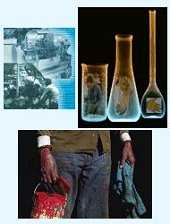Organic Solvents

Solvents are substances that are capable of dissolving or dispersing one or more other substances. Organic solvents are carbon-based solvents (i.e., they contain carbon in their molecular structure). Millions of U.S. workers are exposed to organic solvents that are used in such products as paints, varnishes, lacquers, adhesives, glues, and degreasing/cleaning agents, and in the production of dyes, polymers, plastics, textiles, printing inks, agricultural products, and pharmaceuticals.
Many organic solvents are recognized by NIOSH as carcinogens (e.g., benzene, carbon tetrachloride, trichloroethylene), reproductive hazards (e.g., 2-ethoxyethanol, 2-methoxyethanol, methyl chloride), and neurotoxins (e.g., n-hexane, tetrachloroethylene, toluene). Many different classes of chemicals can be used as organic solvents, including aliphatic hydrocarbons, aromatic hydrocarbons, amines, esters, ethers, ketones, and nitrated or chlorinated hydrocarbons.
NIOSHTIC-2 Search
NIOSHTIC-2 is a searchable bibliographic database of occupational safety and health publications, documents, grant reports, and journal articles supported in whole or in part by NIOSH. After clicking on the link above, users can search within the results generated, or create new searches.
NIOSHTIC-2 search results on organic solvents.
NIOSH Publication Alerts
Alerts briefly present new information about occupational illnesses, injuries, and deaths. Alerts urgently request assistance in preventing, solving, and controlling newly identified occupational hazards.
2-Nitropropane (2-NP)
DHHS (NIOSH) Publication No. 80-142
As a confirmed animal carcinogen, 2-NP has the potential to cause cancer in humans. This document summarizes the cancer studies of 2-NP in laboratory animals and its toxic effects in humans.
Preventing Adverse Health Effects from Exposure to Dimethylformamide (DMF)
DHHS (NIOSH) Publication No. 90-105
This describes engineering controls, good work practices, and personal protective equipment (PPE) recommended for controlling exposures to DMF by inhalation and skin contact.
Preventing Death from Excessive Exposure to Chlorofluorocarbon 113 (CFC-113)
DHHS (NIOSH) Publication No. 89-109
A number of workers have died recently as a result of exposure to CFC-113 in confined spaces or in areas with insufficient ventilation. These workers were apparently unaware that CFC-113 might generate vapor concentrations sufficient to cause death by cardiac arrhythmia or asphyxiation.
Criteria Documents (Criteria for a Recommended Standard)
Criteria documents are developed and recommended by NIOSH for preventing disease and hazardous conditions in the workplace. These documents generally contain a critical review of the scientific and technical information available on the prevalence of hazards, the existence of safety and health risks, and the adequacy of methods to identify and control hazards.
Alkanes (C5-C8) DHHS (NIOSH) Publication No. 77-151
Benzene DHHS (NIOSH) Publication No. 74-137
Benzenethiol DHHS (NIOSH) Publication No. 78-213
Carbon Tetrachloride DHHS (NIOSH) Publication No. 76-133
(Revised Abstract) DHHS (NIOSH) Publication No. 76-133r
Chlorobenzene DHHS (NIOSH) Publication No. 93-102
Chloroform DHHS (NIOSH) Publication No. [75-114]
Cyclohexanethiol DHHS (NIOSH) Publication No. 78-213
2-Diethylaminoethanol DHHS (NIOSH) Publication No. 96-104
Ethylene Dichloride (1,2-Dichloroethane) DHHS (NIOSH) Publication No. 78-211
Ethyl Ether DHHS (NIOSH) Publication No. 93-103
Ethylene Glycol Monobutyl Ether DHHS (NIOSH) Publication No. 90-118
Ethylene Glycol Monobutyl Acetate DHHS (NIOSH) Publication No. 90-118
Ethylene Glycol Monoethyl Ether DHHS (NIOSH) Publication No. 91-119
Ethylene Glycol Monoethyl Ether Acetate DHHS (NIOSH) Publication No. 91-119
Ethylene Glycol Monomethyl Ether DHHS (NIOSH) Publication No. 91-119
Ethylene Glycol Monomethyl Ether Acetate DHHS (NIOSH) Publication No. 91-119
Glycidyl Ethers DHHS (NIOSH) Publication No. 78-166
Isopropyl Alcohol DHHS (NIOSH) Publication No. 76-142
Ketones DHHS (NIOSH) Publication No. 78-173
Metalworking Fluids DHHS (NIOSH) Publication No. 98-102
Methyl Alcohol DHHS (NIOSH) Publication No. 76-148
Methylene Chloride DHHS (NIOSH) Publication No. 76-138
Phenol DHHS (NIOSH) Publication No. 76-196
Propylene Glycol Ethers and Their Acetates DHHS (NIOSH) Publication No. 91-103
Refined Petroleum Solvents DHHS (NIOSH) Publication No. 77-192
1,1,2,2-Tetrachloroethane DHHS (NIOSH) Publication No. 77-121
Thiols, n-Alkane Mono DHHS (NIOSH) Publication No. 78-213
Toluene DHHS (NIOSH) Publication No. 73-11023
1,1,1-Trichloroethane (Methyl Chloroform) DHHS (NIOSH) Publication No. 76-184
Trichloroethylene DHHS (NIOSH) Publication No. 73-11025
Xylene DHHS (NIOSH) Publication No. 75-168
Current Intelligence Bulletins (CIBs)
CIBs review and evaluate new and emerging information about occupational hazards. A CIB may draw attention to a previously unrecognized hazard, report new data on a known hazard, or disseminate information about hazard controls.
Carcinogenic Effects of Exposure to Propylene Oxide —CIB#51
Ethylene Dibromide and Disulfiram Toxic Interaction—CIB#23
Ethylene Dibromide (EDB)—CIB#3
Ethylene Dibromide (EDB) (Revised) —CIB#37
Ethylene Dichloride (1,2-Dichloroethane) —CIB#25
Glycol Ethers: 2-Methoxyethanol and 2-Ethoxyethanol—CIB#39
Hexamethylphosphoric Triamide (HMPA)—CIB#6
Monohalomethanes: Methyl Chloride CH3Cl, Methyl Bromide CH3Br Methyl Iodide CH3I—CIB#43
Organic Solvent Neurotoxicity—CIB#48
Tetrachloroethylene (Perchloroethylene) —CIB#20
Trichloroethylene (TCE)—CIB#2
Other NIOSH Publications
NIOSH Pocket Guide to Chemical Hazards
Exposure limits, Respirator Recommendations, First Aid, more…
The NIOSH Pocket Guide is intended as a source of general industrial hygiene information on several hundred chemicals/classes for workers, employers, and occupational health professionals. The NPG does not contain an analysis of all pertinent data, rather it presents key information and data in abbreviated or tabular form for chemicals or substance groupings (e.g. cyanides, fluorides, manganese compounds) that are found in the work environment. The information found in the NPG should help users recognize and control occupational chemical hazards.
Occupational Health Guidelines for Chemical Hazards
DHHS (NIOSH Publications No. 81-123
These guidelines contain technical information about chemical hazards to workers, employers, and safety and health professionals.
Rubber Products Manufacturing Industry: Special NIOSH Hazard Review
DHHS (NIOSH) Publication No. 93-106
Excess deaths from bladder, stomach, lung, hematopoietic, and other cancers have occurred among workers involved in the manufacture of rubber products. These workers may also risk adverse respiratory effects, dermatologic effects, reproductive effects, injuries, and repetitive trauma disorders.
- Page last reviewed: December 30, 2013
- Page last updated: October 10, 2017
- Content source:
- National Institute for Occupational Safety and Health Education and Information Division


 ShareCompartir
ShareCompartir